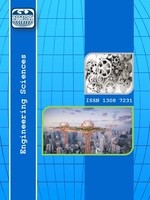ZİRKONYUM KARBÜR ESASLI AŞIRI YÜKSEK SICAKLIK SERAMİK KOMPOZİT TOZLARIN METALOTERMİK YÖNTEMLE ÜRETİMİ
Günümüzde malzeme bilimi çok gelişmiş olmasına rağmen, yeni teknolojik gereksinimler, var olanlardan farklı yeni nesil malzemelere ihtiyaç duyulmaktadır. Yakın bir gelecekte uzay yolculuğunun gerçekleşebilir olması; aşırı yüksek sıcaklık ortamlarında, çok amaçlı ve tekrarlı kullanılabilir seramik kompozit malzemelerin geliştirilmesine bağlıdır. Aşırı yüksek sıcaklık seramik malzemeleri (AYSS veya Ultra high temperature ceramics-UHTC) 2300˚C ve üzerindeki ortamlarda kullanılabilir seramikler olarak tanımlanmaktadır. Bu çalışmada, yüksek ergime noktasına sahip, kimyasal ve termal kararlılığı olan AYSS grubuna ait, ZrB2-ZrC- SiC-Al2O3 seramik kompozit tozlarının üretimi, laboratuvar şartlarında, zirkon, borik asit, metalik alüminyum ve grafit başlangıç karışımı kullanılarak araştırılmıştır. Alüminotermik yöntem kullanılmış, başlangıç karışımları ve elde edilen reaksiyon ürünleri SEM, XRD, XRF, TG/DTA gibi analiz yöntemleri ile analiz edilmiştir. Deneysel şartlara bağlı olarak, başlangıç karışımında bulunan zirkon, çok düşük sıcaklıklarda ayrışmıştır. Zirkonyum ve silisyum oksitleri, ZrC ve ZrB2 ve SiC fazına dönüştüğü görülmüştür. Karbür ve borür fazlarının haricinde, proses edilmiş numunelerde Al2O3 oluşumu da tespit edilmiştir.
Anahtar Kelimeler:
Zirkon, Zirkonyum Borür, Karbür, Alümina, Seramik
PRODUCTION OF ZRC BASED ULTRA HIGH TEMPERATURE CERAMIC COMPOSITE POWDERS BY METALLOTHERMIC METHOD
Although material science is advanced at present time, new technological developments require new generation and different materials that are commercially not available in global market. In order to make long distance space journeys possible in near future, innovation of multipurpose and reusable ceramic composite materials for at high temperature environments are needed. Ceramics that are useable at elevated temperatures as high as 2300˚C are called Ultra high temperature ceramics (UHTC). In this study, the processing of UHTCs based on ZrC/ZrB2/SiC/Al2O3 ceramic composite that has high melting point, chemical and thermal stability, at the laboratory conditions was investigated using zircon, boric acid, carbon and aluminium powders. Aluminothermic method was chosen, the starting mixtures and the obtained reaction products were analysed using SEM, XRD, XRF and TG/DTA analysis methods. The experimental results showed that, the obtained sample consists of ZrB2/ZrC as a matrix phases.
Keywords:
Zircon, Zirconium Diboride, Carbide, Alumina, Ceramic,
___
- [1] Fahrenholtz, W.G., Hilmas, G.E., Talmy, I.G., and Zaykoski, J.A., (2007). Refractory Diborides of Zirconium and Hafnium, J American Ceramic Society. Cilt:90, No:5, ss:1347-1364.
- [2] Paul, A., et all., (2012). UHTC Composites for Hypersonic Applications. American Ceramic Bulletin. Cilt:91, ss:22-29.
- [3] Tang, S. and Hu, C., (2017). Design, Preparation and Properties of Carbon Fiber Reinforced Ultra-High Temperature Ceramic Composites for Aerospace Applications: A Review, J Materials Science and Technology. Cilt:33, ss:117-130.
- [4] Fahrenholtz, W.G., Hilmas, G.E., Chamberlain, A.L., and Zimmermann, J.W., (2004). Processing and Characterisation of ZrB2-based Ultra-High Temperature Monolithic and Fibrous Monolithic Ceramics. J Materials Science. Cilt:39, ss:5951-5957.
- [5] Talmy, I.G., Zaykoski, J.A., and Opeka, M.M., (2010). Synthesis, Processing and Properties of TaC-TaB2-C Ceramics, J European Ceramic Society. Sayı:30, ss:2253-2263.
- [6] Mitra, R., Upender, S., Mallik, M., Chakraborty, S., and Ray, K.K., (2009). Mechanical, Thermal and Oxidation behaviour of Zirconium Diboride Based Ultra-High Temperature Ceramic Composites, Key Engineering Materials. Cilt:395, ss:55-68.
- [7] Bellosi, A. and Scatteia, L., (2008). Processing and Properties Of Ultra-High Temperature Ceramics for Space Applications, Materials Science and Engineering: A. Sayı:485, ss:415-421.
- [8] Ghaffari, A., Faghihi-Sania, A., Golestani-Fardb, F., and Ebrahimi, S., (2013). Pressureless Sintering of Ta0.8 Hf0.2 C UHTC in the Presence of MoSi2, Ceramics International. 39, ss:1985-1989.
- [9] Sciti, D., Silvestroni, L., and Bellosi, A., (2006). High-Density Pressureless-Sintered HfC-based Composites, J American Ceramic Society. Cilt:89 Sayı:8, ss:2668-2670.
- [10] Setoudeh, N. and Weham, N.J., (2014). Carboniridation of Mechanically Activated Mixtures of Zircon And Carbon, J Alloys and Compounds. Cilt:586, ss:730-735.
- [11] Deng, X., ve ark., (2015). Preparation and Characterisation of ZrB2-SiC Composite Powders from Zircon Via Microwave-Assisted boro/carbothermal Reduction, Ceramics Internetional. Cilt:41, ss:1419-1426.
- [12] Ni, D., Zhang, G., Kan, Y., and Wang, P., (2010). Hot Pressed HfB2 and HfB2-20% SiC Ceramics Based on HfB2 Powder Synthesised by Borothermal Reduction of HfO2, Inter J Applied Ceramic Technology. Cilt:7, Sayı:6, ss:830-836.
- [13] Monteverde, F., Melandri, C., and Guicciardi, S., (2006). Microstructure and Mechanical Properties of an HfB2 + 30 vol. %SiC Composite Consolidated by Spark Plasma Sintering, Materials Chemistry and Physics. Cilt:100, ss:513-519.
- [14] Licheri, R., Orru, R., Musa, C., and Cao, G., (2008). Combination of SHS and SPS Techniques for Fabrication of Fully Dense Composite, Materials Letters. Cilt:62, ss:432-435.
- [15] Ran, S., Vanderbiest, O., and Vlengels, J., (2010). ZrB2 Powders Synthesis by Borothermal Reduction, J American Ceramic Society. Cilt:93, Sayı:6, ss:1586-1590.
- [16] Jaalaly, M., Tamizifar, M., Bafghi, M.S., and Gotor, F.J., (2013). Mechanochemical Synthesis of ZrB2-SiC-ZrC Nano Composite Powder by Metallothermic Reduction of Zircon. J Alloys and Compounds. Cilt:581, ss:782-787.
- [17] Atasoy, A., (2010). The Aluminothermic Reduction of Boric Acid, Int. J. Refractory Metals and Hard Materials. Cilt:28, ss:616-622.
- Başlangıç: 2009
- Yayıncı: E-Journal of New World Sciences Academy
Sayıdaki Diğer Makaleler
MÜZİK İŞARETLERİN TEK KANAL KÖR KAYNAK AYRIŞTIRMA İLE AYRIŞTIRILMASI
Hüsamettin ÇELİK, Fatih Yavuz ILGIN, Yusuf SEVİM
THE EFFECTS OF SOLAR CAR DESIGN ON PERFORMANCE
Adem YILMAZ, Selman AYDIN, Rifat YAKUT, Berat Fırat DALĞIÇ
CASE STUDY ON THE IMPLEMENTATION OF THE AUTONOMOUS DRIVING SYSTEMS
